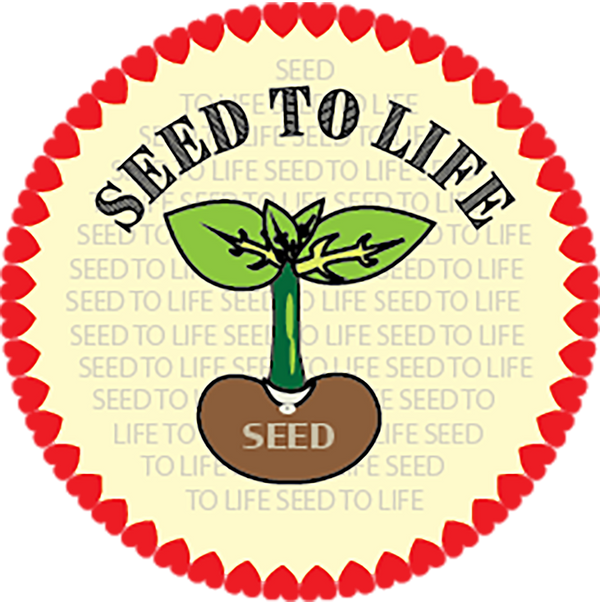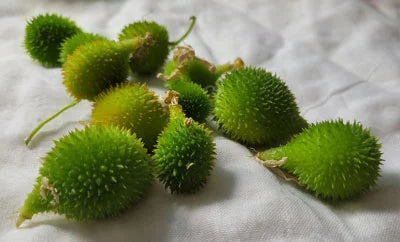
A Wild Vegetable that sells for more than meat
Spiny Gourd Vegetable of the Monsoon
Spiny gourd / Spine Gourd / Kantola (Botanical Name- Momordica balsamina) is a tiny prickly vegetable that reminds you of Karela (Momordica charantia ). It is a common seasonal vegetable in parts of Southeast asia, especially India.

Background and Regional Information
During the month of Shravan (a month marked by significant rainfall) many seasonal vegetables start sprouting all all over the place in rural India. Additionally, many religious people don’t eat non-vegetarian food during this month. Hence, seasonal monsoon vegetables become part of the staple diet during this time. Kantola is one such easy option when not much is growing in the fields yet. Small children and poor people forage these free food options which are highly nutritious and tasty. This is the main reason why a lot of emphasis is given on seasonal foods in Indian culture as it fulfills the dietary requirements of micronutrients. So let’s explore in this article everything about this interesting wild -vegetable gaining popularity internationally.
Other Names of Momordica balsamina
As we discussed earlier, the botanical name of Spiny gourd is Momordica balsamina.
- Kantola (Hindi, Marathi)
- Spiny Gourd
- Spine Gourd
- Bristly Balsam Pear
- Prickly Carolaho
- Karkol vegetable
- Kheksha
- Agakara
- Boda Karakaya
- Teasel Gourds
- Kakara
- Parora
- Kartoli (Bengali)
- Katwal (Gujrati)
- Batkarela (Assame)
- Bharkarela (Punjabi)
- Paalupaikka (Tamil)
- Karkotaki (Telugu)
Spiny Gourd Plant Distribution
Some references suggest that spiny gourd is originally from Africa. But for years these Kantola plants grow as wild vines in bushy areas or jungles. Not just in India but they are also found in other countries in the Indian subcontinent – Pakistan, Nepal, and Srilanka. Moreover, It has now become a seasonally available vegetable in the US and can be found in some Indian or Asian grocery stores. Additionally, interesting thing about Kantola is that despite being a wild vegetable with its increasing popularity it has now become even more expensive than many types of meats. I’m sure that this shift in taste helps to improve biodiversity and makes new delicious food options available to us.
Spine Gourd Nutrition
Spine gourd vegetable is rich in dietary fibers and contains 7.7 g carbohydrate, 3.1 g protein, 3.1 g fat, 3.0 g fiber, and 1.1 g minerals. In addition to this, spine gourd also contains vitamins like ascorbic acid, carotene, thiamin, riboflavin, and niacin. Overall, it is a healthy and tasty option to add fibers to your diet.
Health Benefits of Spine Gourd
Researchers who are studying the benefits of Spine Gourd believe in several of its benefits.
1. High dietary fibers in Kantola help the digestion of food and relieves constipation.
2. Kantola is believed to resolve respiratory issues occurring due to pollution.
3. Kantola fruit powder is used in herbal remedies to remove kidney stones naturally.
4. Other than medicinal benefits, Kantola is used in various delicious curry and stir fries and taste amazing. Only fruits of Kantola are used in cooking.
In addition to the health benefits and culinary uses, Kantola plants can also be used to attract beneficial insects. It is a great high paying crop when cultivated.
Plant description- Kantola /Spine Gourd
Just like other plants from Cucurbitaceae family, Kantola is a vining dioecious plant. That means male and female plants are different. To get fruits you need both types of plants. That is what makes growing these plants in home gardens a little bit tricky. Kantola/ Spiny gourds can be propagated from both seeds and tubers.
Appearance-wise Spiny Gourd resembles Karela a lot. The tubers stay dormant in winter. In the early days of the monsoon season in Southeast Asian countries, these plants start sprouting. The plants can also self-propagate when the ripe fruits break open and drop the seeds down. The seeds may germinate if the weather is suitable and new plants are produced.
Blooming period is between July-October in India. Flowers are tiny, yellow in color. Female flowers have a tiny fruit-like structure at the base whereas male flowers do not have that.
Fruits develop on the fertilized flowers. They are 2-3 cm in length and diameter. Fruits of Kantola have prickly and firm texture. The fruit size of a hybrid variety is usually bigger. Also, the hybrid variety shows better resistance to the diseases. Fruits quickly mature just in 3-4 days. If not harvested, the fruits turn yellowish from green just like bitter gourd. The pulp is white at first but as the fruits mature, it turns bright red-orange in color. Finally, the fruits break open to throw the seeds out. The seeds are usually 12-15 in number. They are around 1/2-2/3 cm in diameter and white in color.
How to differentiate between male and female Spiny Gourd Plants?
There are two easy ways gardeners can differentiate between male and female Kantola plants without using any advanced technology or testing.
- First, in my observation, female plants have tubers bigger and thicker compared to that of male plants.
- But how to identify the male and female plants when the plants are already growing?- The easiest way is to look at flowers. Like cucumbers, zucchini, and several other gourds; Spiny gourd female flowers have a tiny unfertilized fruit at the base of the flower. If the flower is fertilized, this tiny fruit matures into a proper fruit. But, if it doesn’t fertilize then it turns yellow and falls off.
Growing Spiny Gourd or Kantola From Seeds and Tubers General Information
Whether you grow spiny gourd from seeds or from tubers, the plants perform best in hot humid climates with temperatures ranging between 25-40°C or 77-104°F. Kantola is not choosy about the type of soil and grows well in all types of soil including clay, loamy, or sandy in the wild. However, to prevent the roots from getting infected due to excess moisture, it is better to use sandy or loamy soil. The optimal pH ranges between 6-7.
In the initial growing period, you can use any high-nitrogen fertilizer for the first 4-6 weeks. After about a month you can feed these plants with any balanced all-purpose fertilizer or a mixture of blood and bone meal.
How to Grow Kantola From Seeds?
First of all, whether you grow Kantola from seeds or tubers, you have to grow more plants. Growing Spiny Gourd or Kantola from seeds is very easy. You can sow the seeds 1/2-1 inch deep. Germination time is 3-10 days. You can direct sow the seeds in early spring or start them indoors 6-8 weeks before the last frost date. Since the plants are going to develop tubers, it is good to keep at least 8 inches of spacing between two plants. You can grow them in containers or directly in the ground. It takes approximately two-three months for the plants to reach maturity.
How to Grow Kantola/ Spiny Gourd From Tubers?

In winter when the Kantola plants go dormant, you can dig out the tubers and save them. I just bring the containers indoors and stop watering completely. These tubers are very susceptible to fungal infection and root rot. So, it is important that the soil should be very well draining. There is another hybrid variety of Kantola that is more disease resistant and produces bigger fruits but the original variety is not very strong.
Overwintering Kantola Plants or Tubers
If you are already growing Kantola from seeds then you can preserve the tubers in winter indoors and bring them out for planting when the weather is suitable again that is in early spring. Plant them in a well draining loamy soil. Soon the vines will start growing back. Growing spiny gourd from tubers have one additional benefit. The fruits are produced early and in bigger quantity.
Pests affecting Spinela Gourd or Kantola
As discussed earlier, Kantola plants get affected easily by root rot and fungal infection. Pests affecting other Cucurbita plants like cucurbit beetles also can cause some damage. You can use the sticky insect traps, other flying insect traps, or neem spray. Having the predators like wasps, anoles and lizards also help to control the pests.

